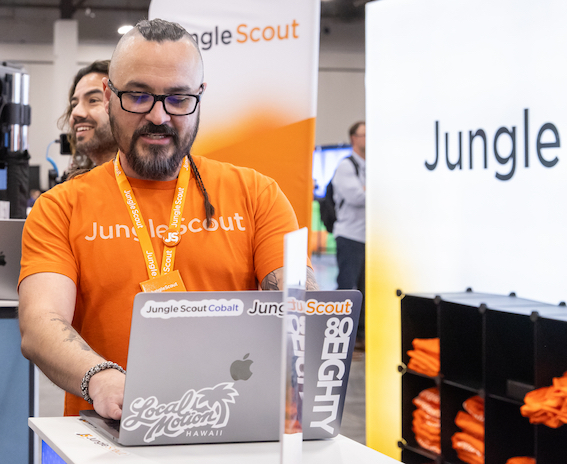May 23, 2025
WASHINGTON, D.C. – The 145% tariff on Chinese goods lasted for about a month before the Trump administration lowered it to 30%. China followed suit with a tariff reduction to 10% on U.S. goods.
The 90-day pause amounts to a breather, but online sellers are frustrated. “Sellers are stocking up like there is no tomorrow,” says Cardy Chung, founder and CEO, StreetPricer. “That’s what we hear through the grapevine.” Is stocking up a good idea? What strategy should online sellers be employing during the latest tariff pause? Prosper Show newsletter asked the question and our experts had a lot to say.
 “During this current pause, now is the time to focus on profitability. We are probably going to see fewer sales over the summer as brands hunker down to stockpile cash. However, if the tariffs don’t come back into effect, I could see how, if brands position themselves that way, they’d be in a great situation to have an amazing Q4. Brands will also want to look at diversifying their supply chain and increasing inventory, which will buy them more time in case the tariffs do go back into effect. Right now, everyone has been given a chance to take a breather and really look at their business to be in a much safer position, and brands need to take advantage of it right away.” — Andrew Maffettone, founder and CEO, BlueTuskr
“During this current pause, now is the time to focus on profitability. We are probably going to see fewer sales over the summer as brands hunker down to stockpile cash. However, if the tariffs don’t come back into effect, I could see how, if brands position themselves that way, they’d be in a great situation to have an amazing Q4. Brands will also want to look at diversifying their supply chain and increasing inventory, which will buy them more time in case the tariffs do go back into effect. Right now, everyone has been given a chance to take a breather and really look at their business to be in a much safer position, and brands need to take advantage of it right away.” — Andrew Maffettone, founder and CEO, BlueTuskr
“Prepare your buyers for the added costs. Look at the supply chain to try and reduce costs by perhaps outsourcing production and/or warehousing-fulfillment resources; depending on the overall volume, it might be a good time to review shipping solutions to offset the tariffs.” — Michael Recchia, national account manager, ePost Global
“My product is made in America, so I believe I will benefit from any tariff increase. However, I think it may take some time before inventory shortages start proving that theory.” — David Hewlett, owner, SmartLabels
“We’re seeing some of our largest clients working hard on diversifying their supply chain, optimizing inventory by stocking up on certain key products, and reassessing pricing strategies if tariff hikes return.” — Josh Hall, founder, Micromercial
 “Even though tariffs have been reduced, they are still higher than where we started in 2025. And while we are getting a respite from those sky high tariffs of April, there are still additional costs to be dealt with. In some cases, freight arrived in the US during this trade war, and those costs must still be absorbed somewhere. Second, there is absolutely no guarantee that tariffs won’t skyrocket again. As I mentioned in an earlier Prosper Show newsletter, this is a wake up call for process improvement within your business. The brands and sellers on Amazon that are fluid and can pivot quickly still need to. Those that are more entrenched get time to become flexible. You have a break from the pressure of the past months, but it doesn’t mean you can sit back on your heels and do nothing. Now is the time, while you have a bit of breathing room, to continue overhauling and improving your entire business process and supply chain. Use this time to find those inefficiencies, identify cost reduction opportunities, create new approaches—test and iterate on the results. Right now is the time to take the recent lessons (painful as they may have been) and learn from that experience, so you are better prepared to deal with these external factors to which you have very little control. Focus on the things you can control, and leverage those things aggressively and relentlessly.” — Brandon Bastin, senior enterprise onboarding & training specialist, JungleScout
“Even though tariffs have been reduced, they are still higher than where we started in 2025. And while we are getting a respite from those sky high tariffs of April, there are still additional costs to be dealt with. In some cases, freight arrived in the US during this trade war, and those costs must still be absorbed somewhere. Second, there is absolutely no guarantee that tariffs won’t skyrocket again. As I mentioned in an earlier Prosper Show newsletter, this is a wake up call for process improvement within your business. The brands and sellers on Amazon that are fluid and can pivot quickly still need to. Those that are more entrenched get time to become flexible. You have a break from the pressure of the past months, but it doesn’t mean you can sit back on your heels and do nothing. Now is the time, while you have a bit of breathing room, to continue overhauling and improving your entire business process and supply chain. Use this time to find those inefficiencies, identify cost reduction opportunities, create new approaches—test and iterate on the results. Right now is the time to take the recent lessons (painful as they may have been) and learn from that experience, so you are better prepared to deal with these external factors to which you have very little control. Focus on the things you can control, and leverage those things aggressively and relentlessly.” — Brandon Bastin, senior enterprise onboarding & training specialist, JungleScout
“The latest tariff pause provides a rare strategic window to strengthen operations. It’s a chance to reassess SKU-level exposure, secure inventory at pre-tariff rates, and test pricing strategies without the full pressure of cost increases. It’s also the right time to implement automation and demand forecasting tools so that when volatility returns, brands and sellers can respond with agility and precision rather than reacting and scrambling.” — Dani Nadel, president and COO, Feedvisor
 “I’m hopeful we’ll see tensions with China ease and some form of long-term peace take shape—but nothing’s guaranteed. This tariff pause isn’t a fix. It’s a short window to get ahead before the next disruption. At ALT Group, we’re bringing in inventory now to stay ahead of any immediate spikes, but we’re also making diversification a top priority—whether that’s sourcing from Vietnam, Mexico, or shifting parts of the supply chain to the U.S. Sellers who are too exposed to one region are playing with fire. If you’re not actively working on a backup plan, you’re already behind. Use this time to optimize margins, tighten logistics, and line up alt suppliers. It’s not about panic—it’s about being the one who’s ready when others aren’t.” — Dakota Morse, founder, ALT Group
“I’m hopeful we’ll see tensions with China ease and some form of long-term peace take shape—but nothing’s guaranteed. This tariff pause isn’t a fix. It’s a short window to get ahead before the next disruption. At ALT Group, we’re bringing in inventory now to stay ahead of any immediate spikes, but we’re also making diversification a top priority—whether that’s sourcing from Vietnam, Mexico, or shifting parts of the supply chain to the U.S. Sellers who are too exposed to one region are playing with fire. If you’re not actively working on a backup plan, you’re already behind. Use this time to optimize margins, tighten logistics, and line up alt suppliers. It’s not about panic—it’s about being the one who’s ready when others aren’t.” — Dakota Morse, founder, ALT Group
 “During the latest tariff pause, online sellers should proactively test pricing strategies in anticipation of potential cost increases. Whether tariffs return or a shift in manufacturers changes cost structures, sellers need to understand how price adjustments will affect perceived value and competitiveness. With PickFu, they can safely simulate these scenarios—testing price points, product positioning, and messaging against real consumers—before making costly changes.
“During the latest tariff pause, online sellers should proactively test pricing strategies in anticipation of potential cost increases. Whether tariffs return or a shift in manufacturers changes cost structures, sellers need to understand how price adjustments will affect perceived value and competitiveness. With PickFu, they can safely simulate these scenarios—testing price points, product positioning, and messaging against real consumers—before making costly changes.
“For those exploring global expansion, this is also the ideal time to test international appeal. PickFu allows sellers to experiment with localized packaging, branding, and messaging tailored to new Amazon marketplaces. Cultural preferences can vary dramatically, and what works in the U.S. may not convert abroad. Instead of guessing, sellers can use PickFu as a safe sandbox to validate ideas and de-risk expansion efforts—without committing to full-scale launches or expensive localization upfront. In times of policy uncertainty, the smartest sellers don’t wait—they test early, iterate fast, and move with confidence.” — Justin Chen, co-founder, PickFu
 “With the current tariff pause creating a temporary window of opportunity, online sellers should adopt a balanced approach that leverages immediate savings while preparing for potential future changes. Consider increasing inventory of affected products strategically—not overstocking, but securing enough supply to maintain competitive pricing advantages for 3-6 months beyond the pause period. Simultaneously, diversify your supply chain by exploring alternative sourcing options, particularly from countries not impacted by the tariff situation. This pause offers an ideal time to negotiate better terms with existing suppliers who are experiencing relief from tariff pressures. Most importantly, maintain pricing flexibility in your systems to quickly adapt when the tariff landscape inevitably shifts again.” — Nizar Noorani, founder, SellerChamp
“With the current tariff pause creating a temporary window of opportunity, online sellers should adopt a balanced approach that leverages immediate savings while preparing for potential future changes. Consider increasing inventory of affected products strategically—not overstocking, but securing enough supply to maintain competitive pricing advantages for 3-6 months beyond the pause period. Simultaneously, diversify your supply chain by exploring alternative sourcing options, particularly from countries not impacted by the tariff situation. This pause offers an ideal time to negotiate better terms with existing suppliers who are experiencing relief from tariff pressures. Most importantly, maintain pricing flexibility in your systems to quickly adapt when the tariff landscape inevitably shifts again.” — Nizar Noorani, founder, SellerChamp
